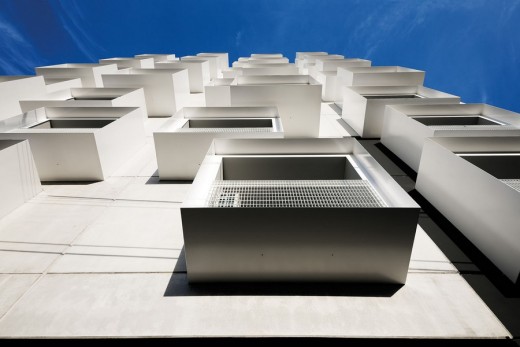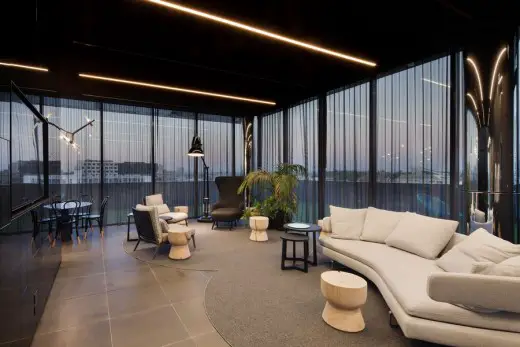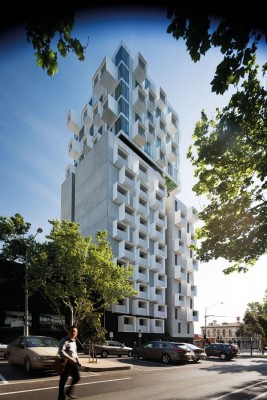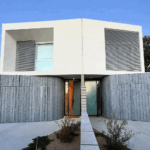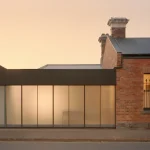Upper House Melbourne Residences, Victoria Homes, Australian Architecture, Images
Upper House Melbourne
Contemporary Housing in Australia – design by Jackson Clements Burrows
12 Aug 2015
Upper House in Melbourne, Victoria
Design: Jackson Clements Burrows
Location: Corner Swanston and Queensberry Streets, Melbourne, Victoria, Australia
Upper House is a 17 storey apartment building consisting of 110 apartments with two street level commercial tenancies. The unique composition of the building mass was conceived through a series of innovative urban design and social gestures resulting in a building form that is comprised of several discrete elements.
Aiming to achieve both environmental and social sustainability, Level 11 has been given over as a communal space, ‘the Observatory’, featuring a gymnasium, lounge and dining area overlooking a garden roofscape. The communal space is elegantly furnished and provides for a range of day and night time activities by the residents. This important social gesture creates an implied physical break in the building, a break which is heightened by the mirrored soffit to the upper section so that the garden roofscape and its social activity is reflected to the street level below, providing a visual cue to the elevated garden above.
The upper levels, beyond the mirrored soffit, are clad in a white glass curtain wall that is partially transparent, enabling a degree of reflectivity to suggest the ephemeral, offset against the concrete base below. All apartment glazing between levels 12-16 are double glazed supertoned with 10mm argon gap and low e glass with a window U value of 7.32.
The podium facade is precast concrete providing thermal mass for an even temperature. The building is 6.0 star energy rated and compliant with BCA sustainable design requirements. The “Keim” precast finish is a natural, liquid silicate paint which provides an extremely durable and sustainable finish.
The second innovative gesture is the introduction of a break, or ‘ravine’, in the lower podium body of the building which divides it into two separate forms to produce a naturally ventilated breezeway. The breezeway is automated, utilizing live weather data to open and close the louvres depending upon weather conditions. For the occupants, the breezeway establishes an important visual and spatial connection to their surroundings. It also avoids a ‘sealed corridor solution’ with its associated problems of stale air, food smells and artificial light.
Across both the upper and lower facades, a scattering of cantilevered balconies and alternating window placements unite the two facades aesthetically with an engaging three dimensional quality which creates an eye catching, distinctive and engaging vertical topography.
At street level, a partly transparent plinth is articulated as a black reveal with projecting steel looped windows to the commercial tenancies and the entry lobby. Given the proximity to public transport, important for the project was the desire to eliminate the need for cars. Instead 65 bicycle spaces and ‘share cars’ have been provided for the occupants.
The material contrast between the lower and upper mass amplifies the sense of a formal break and the idea of a building which is floating across the skyline ‘like a cloud’. The apartments are fresh with restful neutrals, allowing visual impact and accents to be tailored by each resident to their own personal style.
Upper House demonstrates a clarity in urban composition and social program to engage with its context in a new and positive way.
Upper House – Building Information
Architect: Jackson Clements Burrows
Location: Corner Swanston and Queensberry Streets, Melbourne, Victoria, Australia
Scale: 110 Apartments over 17 storeys 50,000 sqm
Disciplines: Architecture, Interior Design, Masterplanning and Urban Design
Completed: November 2014
Images: John Gollings and Shannon McGrath
Recognition
2015 Victorian Architecture Awards, Best Overend Award for Multi-Residential Architecture
The big idea
Upper House demonstrates a clarity in urban composition and a social program that engages with its context in a new and positive way. The unique composition of the building is conceived with the communal space at the heart of the building.
Jackson Clements Burrows (JCB)
Jackson Clements Burrows is an award-winning architectural practice with a strong design focus, motivated by a desire to provide sensitive and stimulating environments which achieve unique and creative solutions. Based in Melbourne, the practice is led by the three directors: Tim Jackson, Jon Clements and Graham Burrows.
Upper House in Melbourne images / information from Jackson Clements Burrows
Location: Melbourne, Victoria, Australia
Architecture in Melbourne
Melbourne Architecture Designs – chronological list
Melbourne Architecture Walking Tours
Melbourne Architect Offices – design studio listings
Architecture in Australia
Cloud House North Fitzroy
Architect: McBride Charles Ryan
Comments / photos for Upper House in Melbourne page welcome
Website: Jackson Clements Burrows

